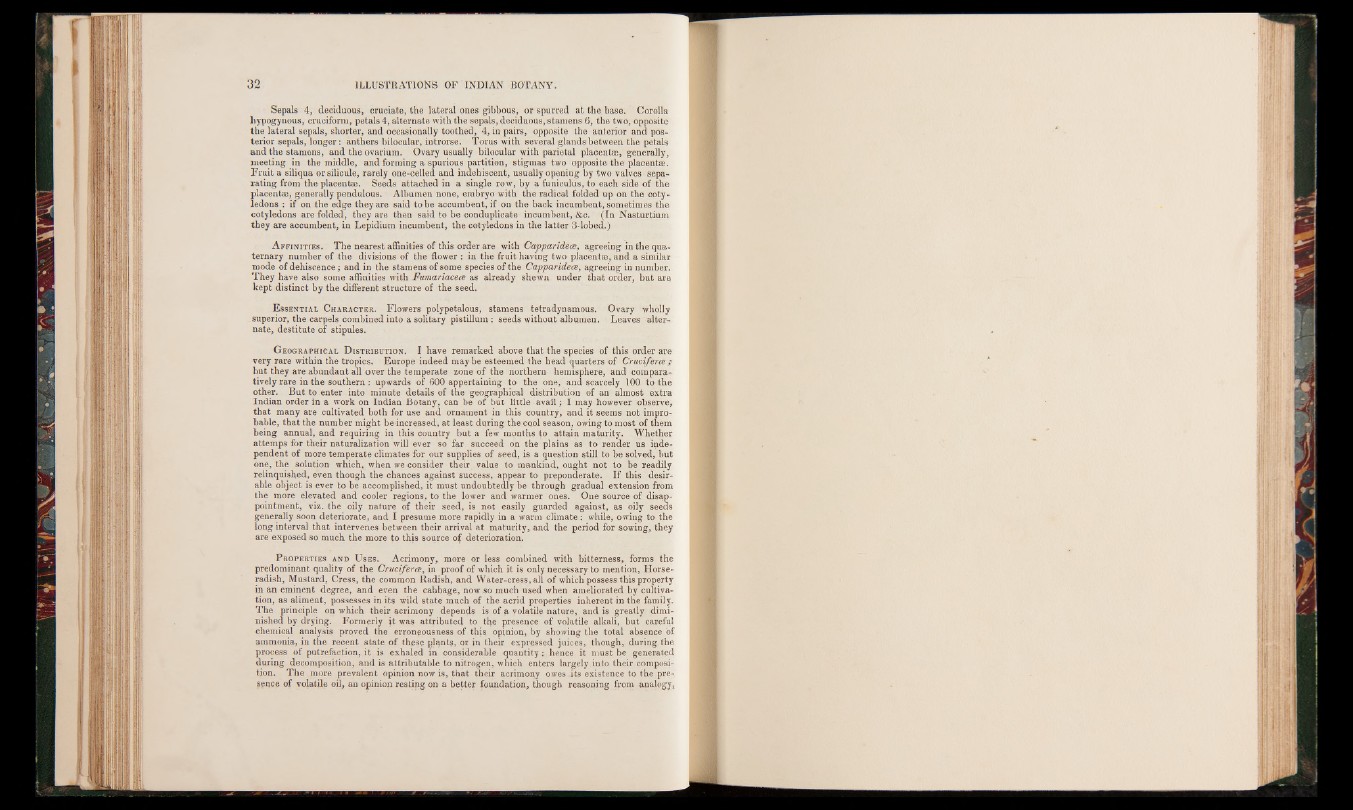
Sepals 4, deciduous, cruciate, the lateral ones gibbous, or spurred at the base. Corolla
hypogynous, cruciform, petals 4, alternate with the sepals, deciduous, stamens 6, the two, opposite
the lateral sepals, shorter, and occasionally toothed, 4, in pairs, opposite the anterior and posterior
sepals, longer: anthers bilocular, introrse. Torus with several glands between the petals
and the stamens, and the ovarium. Ovary usually bilocular with parietal placentae, generally,
meeting in the middle, and forming a spurious partition, stigmas two opposite the placentae.
Fruit a siliqua orsilicule, rarely one-celled and indehiscent, usually opening by two valves separating
from the placentae. Seeds attached in a single row, by a funiculus, to each side of the
placentae, generally pendulous. Albumen none, embryo with the radical folded up on the cotyledons
: if on the edge they are said to be accumbent, if on the back incumbent, sometimes the
cotyledons are folded, they are then said to be conduplicate incumbent, &c. (In Nasturtium
they are accumbent, in Lepidium incumbent, the cotyledons in the latter 3-lobed.)
A f f in it ie s . The nearest affinities of this order are with Capparidece, agreeing in the quaternary
number of the divisions of the flower : in the fruit having two placentae, and a similar
mode of dehiscence; and in the stamens of some species of the Capparidece, agreeing in number.
They have also some affinities with Fumariacece as already shewn under that order, but are
kept distinct by the different structure of the seed.
E ssentia l C haracter. Flowers polypetalous, stamens tetradynamous. Ovary wholly
superior, the carpels combined into a solitary pistillum : seeds without albumen. Leaves alternate,
destitute of stipules.
G eographical D istribu tion. I have remarked above that the species of this order are
very rare within the tropics. Europe indeed maybe esteemed the head quarters of Cruciferce/
but they are abundant all over the temperate zone of the northern hemisphere, and comparatively
rare in the southern: upwards of 600 appertaining to the one, and scarcely 100 to the
other. But to enter into minute details of the geographical distribution of an almost extra
Indian order in a work on Indian Botany, can be of but little avail; I may however observe,
that many are cultivated both for use and ornament in this country, and it seems not improbable,
that the number might be-increased, at least during the cool season, owing to most of them
being annual, and requiring in this country but a few months to attain maturity. Whether
attemps for their naturalization will ever so far succeed on the plains as to render us independent
of more temperate climates for our supplies of seed, is a question still to be solved, but
one, the solution which, when we consider their value to mankind, ought not to be readily
relinquished, even though the chances against success, appear to preponderate. If this desirable
object is ever to be accomplished, it must undoubtedly be through gradual extension from
the more elevated and cooler regions, to the lower and warmer ones. One source of disappointment,
viz. the oily nature of their seed, is not easily guarded against, as oily seeds
generally soon deteriorate, and I presume more rapidly in a warm climate: while, o wing to the
long interval that intervenes between their arrival at maturity, and the period for sowing, they
are exposed so much the more to this source of deterioration.
P rop erties and U se s . Acrimony, more or less combined with bitterness, forms the
predominant quality of the Cruciferce, in proof of which it is only necessary to mention, Horseradish,
Mustard, Cress, the common Radish, and Water-cress, all of which possess this property
in an eminent degree, and even the cabbage, now so much used when ameliorated by cultivation,
as aliment, possesses in its wild state much of the acrid properties inherent in the family.
The principle on which their acrimony depends is of a volatile nature, and is greatly diminished
by drying. Formerly it was attributed to tfye presence of volatile alkali, but careful
chemical analysis proved the erroneousness of this opinion, by showing the total absence of
ammonia, in the recent state of these plants, or in their expressed juices, though, during the
process of putrefaction, it is exhaled in considerable quantity : hence it must be generated
during decomposition, and is attributable to nitrogen, which enters largely into their composition.
The more prevalent opinion now is, that their acrimony owes-its existence to the pre-
Sgpce of volatile oil, an opinion resting on a better foundation, though reasoning from analogy4